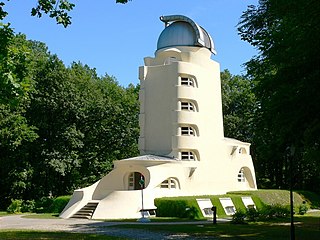 | ||
| Potsdam | ||
| federal state | Brandenburg | |
|---|---|---|
| Residents | 180.334 (2019) | |
| height | 35 m | |
| Tourist info | 49 (0)331 2755 8899 Tourist Information Potsdam | |
| no tourist info on Wikidata: | ||
| location | ||
| ||
Potsdam, the capital of the state Brandenburg, with its 180,000 inhabitants is directly adjacent Berlin. The extensive cultural landscapes with lavish parks and lakes, hills and castles laid out over several centuries were included in the list of world cultural and natural heritage by UNESCO in 1990 as the largest ensemble of German world heritage sites.
background


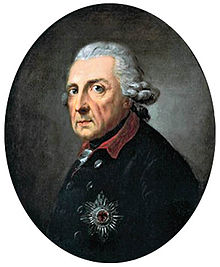
Potsdam was first mentioned in a document in 993 under the name “Poztupimi”. The Slavic settlement was donated by Emperor Otto III. to the pen in Quedlinburg transfer. In 1157 Albrecht the Bear conquered the settlement and assigned it to the new Mark Brandenburg. In 1317 a castle was built in the outpost at the Havel crossing, and in 1347 Potsdam was granted city rights. In 1415 the Mark Brandenburg was transferred to the House of Hohenzollern as a fief, which it was to remain until the end of the First World War.
In 1653, Potsdam was named the second royal seat of Brandenburg-Prussia alongside Berlin. The "Great Elector" Friedrich Wilhelm von Brandenburg (1620–1688) had the palace built and the pleasure garden laid out from 1660-1682, drew in French refugees through the Edict of Potsdam of November 8, 1685 and made Potsdam a residence. His grandson King Friedrich Wilhelm I declared Potsdam a garrison town, carried out the baroque city extensions (1733-1742), had the city wall built, the city canal built and the Dutch Quarter built. The Havel residence owes its splendor to his successor Frederick the Great. Under him the park and the Sanssouci Palace and the New Palace were built in front of the city. In the urban area, Friedrich gave the city palace its baroque appearance and turned Potsdam into a baroque total work of art through hundreds of splendid renovations and new buildings. Friedrich Wilhelm IV. Expanded and changed the Sanssouci Park under the direction of Peter Joseph Lenné and had Charlottenhof Palace and the Orangery Palace built there.
From April 14th to 15th, 1945, during the so-called "Night of Potsdam", an air raid by the British Royal Air Force took place, which destroyed large parts of Potsdam's inner city. After the war, Potsdam was rebuilt mainly with modern buildings during the SED rule. After the fall of the Wall in 1989, attempts were made to revive the historic cityscape in Potsdam's inner city by reconstructing baroque buildings and the city canal.
The city received international attention as the venue for the "Potsdam Conference" in 1945 in Cecilienhof Palace, where the three main allies of World War II decided on the future of Germany.
The city of Potsdam is divided into 34 districts and 84 statistical districts. The following 8 urban areas are sufficient for an overview:
- Potsdam North
- Northern suburbs
- Western suburbs
- Downtown
- Babelsberg
- Potsdam south
- Potsdam southeast
- Northern districts
getting there
| Distances | |
| Hall | 143 km |
|---|---|
| Leipzig | 139 km |
| Magdeburg | 120 km |
| Dessau | 99 km |
| Brandenburg on the Havel | 38 km |
| Berlin | 36 km |
In the street
Potsdam is surrounded by the A 10 and A 115 motorways with connections to it A 9 or A 2. Furthermore, one can orientate oneself on the direction signs of Berlin.
The following federal highways lead through or to Potsdam:
- B 1 Berlin-Wannsee - Potsdam - Brandenburg on the Havel
- B 2 Berlin-Spandau - Potsdam - Lutherstadt Wittenberg
- B 273 Oranienburg – Nauen - Potsdam
Due to the extensive commuting, the sometimes cumbersome routing and frequent construction sites, there can be significant congestion in the city during rush hour on weekdays. Especially on the major feeder roads, i.e. the B1 (west via Werder (Havel) to the A10 or east via Wannsee to the A115), the B2 (south via Michendorf to the A10 or north via Groß Glienicke to Berlin-Spandau), the B273 ( north-west via Marquardt to the A10) and the L40 (south-east via Babelsberg to the A115), waiting times and slow traffic are to be expected.
By plane
Potsdam's closest airport is the Berlin Brandenburg Airport![]() (IATA: BER). From Potsdam you can get to the airport 40 kilometers away by car via the A10 motorway (Berliner Ring). By train, Schönefeld can be reached without changing with the train line RB21 / 22 or from the Potsdam-Rehbrücke station or from the nearby Berlin-Wannsee station with the RE7 train line.
(IATA: BER). From Potsdam you can get to the airport 40 kilometers away by car via the A10 motorway (Berliner Ring). By train, Schönefeld can be reached without changing with the train line RB21 / 22 or from the Potsdam-Rehbrücke station or from the nearby Berlin-Wannsee station with the RE7 train line.
By train
Potsdam has a total of nine train stations, so that traveling by train is basically possible. However, Potsdam has been largely excluded from long-distance traffic since 2005. Currently only the IC 2431/2432 between Emden and Cottbus (with stops in Hanover and Bremen) once a day on 1 Potsdam Central Station. In addition, Potsdam can be reached at around 0:45 at night with the ICE948 from Berlin to Cologne. Traveling by long-distance train connections therefore almost always requires a change at Berlin Central Station.
Potsdam is often connected to the surrounding area, especially Berlin, via regional train connections, with these stopping at a total of six Potsdam train stations. The most important line, and one that is very popular with commuters, is the Regional Express 1 (RE1), which connects Potsdam with Brandenburg an der Havel and Magdeburg or with Berlin and Franfurt / Oder. With no less than four stops in the city (Griebnitzsee, Hauptbahnhof, Charlottenhof and Park Sanssouci), the line is also suitable for inner-city transport. The RE1 runs every hour on weekdays between 5 a.m. and 10 p.m. The are still important for a journey Regional train lines RB21 and RB22 with which Potsdam is also connected to Berlin (with a stop in Griebnitzsee) or without changing to Schönefeld Airport. At most, the regional express 7 (RE7), which connects the south of Potsdam (Rehbrücke and Medienstadt Babelsberg stations) from Dessau with Berlin, is suitable for traveling from central Germany. The regional train lines RB20 and RB23, which also stop in the city, connect Potsdam with the nearby Michendorf and Oranienburg and are particularly interesting for commuters and trips to the surrounding area. The Pirschheide, Golm and Marquardt train stations also serve stops that can be used for inner-city transport.
The is an essential backbone for the connection to Berlin Berlin S-Bahn line S7. This leads from Potsdam over the east-west route through Berlin to Ahrensfelde. Thanks to the almost continuous 10-minute cycle, it is often the fastest connection between Potsdam and Berlin - despite the slightly longer journey time than the regional trains running in parallel. Within the city, the S7 stops in Griebnitzsee, Babelsberg and ends at Potsdam Central Station. The S7 runs between Potsdam and Berlin between 3 a.m. and 1 a.m. on weekdays, and runs almost continuously on weekends with only a one-hour break at 3 a.m.
Another important interchange station in regional traffic when traveling to and from Potsdam is Berlin-Wannsee, where several S-Bahn and regional train lines intersect. In general, a VBB Berlin ABC ticket is required for the journey from the center of Berlin to Potsdam, which currently costs € 3.80 (as of April 6, 2021). When traveling there, you should generally note that the trains can get very full during normal commuter traffic times. This applies in particular to the RE1, but also to the S7 and RB21.
By boat
It is generally possible to travel to Potsdam by ship via the Havel. However, there is no regular regular service between Berlin (Spree) and Potsdam (Havel). Both from Berlin's Wannsee and Spandau, however, excursion steamers regularly run to the center of Potsdam in the warm months.
If you arrive with your own boat, you will find several chargeable berths with overnight accommodation. The Marina am Tiefen See is located directly on Schiffbauergasse, and on the opposite side of the Havel in the Babelsberg Park, the Potsdamer Seesportclub e.V. has guest berths ready. Further down the Havel is the Neustädter Havelbucht marina and the Potsdam marina opposite the Hermannswerder peninsula. Finally, the boat center at Krampnitzsee, near the northern suburb of Neu Fahrland, offers berths a little further outside.
Day visitors who travel across the water in their own vehicle will find public sports boat berths very centrally located on the Alte Fahrt or near the Glienicke Bridge in the fashionable Berlin suburbs. These can be used free of charge between 6 a.m. and 10 p.m.
mobility
Pedestrian traffic
Potsdam is generally quite pedestrian-friendly, and practically all areas of the city can be safely reached and explored on foot. There are numerous (city) hiking trails in and around Potsdam. In addition, the European long-distance hiking trails cross in Potsdam E10 and E11.
In particular, the historic city center around Brandenburger Strasse and the Holländerviertel should be explored on foot. Many shops invite you to stroll, and around Brandenburger Straße there is also one or the other extensive backyard to discover.
The Havel and the many lakes offer space for lovely long walks in the countryside. So you can walk almost continuously from the Long Bridge (starting point at the White Fleet) along the Havel along the water to the Pirschheide train station. We also recommend the Hermannswerder peninsula, which invites you to take a leisurely tour (best reached by ferry from Kiewitt).
Unfortunately, the Griebnitzsee is a negative exception. Since a good dozen villa residents have been resisting public access to their properties acquired at ridiculous prices after reunification for years, the lake can only be accessed selectively from the villa district of Babelsberg.
Public transport

Potsdam is well supplied with buses and trains, but it is easy to get lost in the tariff jungle. In general, Berlin, Potsdam and parts of Brandenburg are part of the VBB, the Berlin-Brandenburg transport association. With most tickets you can change to other means of transport without hesitation. For this purpose, different zones with different prices have been set up. It should be noted, however, that Berlin and Potsdam each have their own, but overlapping 3-zone model for their tariffs.
The Potsdamer Verkehrsbetriebe (ViP) divides its tariff area into zones A, B and C. Potsdam's inner city is in zone A, the outer city districts in zone B, and the surrounding area of Brandenburg (but not Berlin!) In zone C. The tariffs for Single ticket Potsdam FROM € 2.10, Potsdam ABC € 2.60, for the day ticket Potsdam FROM € 4.20, Potsdam ABC € 5.80 or the small group day ticket Potsdam FROM € 10.50, Potsdam ABC € 14.70 (Status: 1.5.2019).
For trips to and from Berlin, the Berlin zoning applies BVG zone, whereby the Berliner Verkehrsbetriebe (BVG) also subdivide into A, B and C. The area within the Berlin S-Bahn ring is tariff area A, the rest of Berlin's urban area is tariff area B and the Brandenburg area (including Potsdam!) Is tariff area C. The tariffs for the single ticket Berlin BC are € 3.50, Berlin ABC 3 , € 80, for the 24-hour ticket Berlin BC € 9.20, Berlin ABC € 10.00, for the small group ticket Berlin BC € 26.00, Berlin ABC € 26.50 (As of 6.4.2021) .
In Potsdam, tickets can be taken directly from machines on the buses and trams, which unfortunately do not really help you choose the right card. The best thing to do is to find out more about details and exact fares at Potsdam Central Station Homepage of the VBB or the Potsdam public transport operator Transport company Potsdam. When traveling by bus to the Brandenburg area, you can pay directly to the driver. Tickets for the S-Bahn or regional trains to Berlin must be bought at the station at the machine or counter, they cannot (!) Be purchased on the train.
More timetables under www.regiobus-pm.de
Road traffic
On www.mobil-potsdam.de you can find current information on road traffic such as traffic web cams and construction sites. Due to the high proportion of commuters, traffic jams are the rule, especially in rush-hour traffic, which is why you should ideally avoid using a car for getting around within the city.
Six Park & Ride parking spaces have been set up in and around the city, where you can easily switch from your car to public transport. These are:
- at Pirschheide station, in the west on the B1 to Werder (Havel)
- at Rehbrücke station, in the south at the RE7 stop
- on Johannes-Kepler-Platz, in the populous suburb of Am Stern in the southeast
- at the Griebnitzsee station, on the S-Bahn line in the east
- at Babelsberg Park and Palace in Babelsberg
- at Buga-Park / Volkspark, in the north on the B2 in the direction of Spandau
Pushing back motorized individual transport is the declared aim of the urban development concept for transport. As a consequence, parking space management has been gradually expanded so that free parking spaces are practically no longer to be found, at least close to the city center. The parking space management takes place in three zones, whereby in Zone 1 (inner city around Brandenburger Straße) € 2.00, in Zone 2 (city districts close to the city center) € 1.50 and in Zone 3 (inner city outskirts) € 1.00 per hour are. In zones 1 and 2, so-called mobile phone parking, i.e. paying the parking fee by SMS, is possible almost everywhere.
If you still want to go into town with your own vehicle, a total of 13 parking garages have around 2500 parking spaces available. For example, the car parks at the main train station, the Wilhelm-Galerie underground car park, the Karstadt car park on the municipal administration railing or the underground car park at Luisenplatz are located close to the center and the sights. The fees are between € 1.50 and € 4.00 per hour, depending on the car park and location.
Shipping
In Potsdam there is only one urban ferry line (F1) that can be used with regular public transport tickets. It runs between the Hermannswerder peninsula and the Kiewitt in the Brandenburg suburb and can only be used by pedestrians and cyclists.
The Potsdam water taxi also offers regular ferry service for pedestrians and cyclists. The water taxi runs on the Havel between the Sacrow Park in the north and the Templin lido in the south. It heads for 13 piers, mostly close to large hotels and tourist attractions, and its price is more geared towards excursion guests than Potsdamers. The tariffs are staggered depending on the number of stations or tariff zones (4 or 5 stations together form a zone) and start at € 4.00 for a single station or € 7, € 10 or € 13 for driving one, two or three zones. The first trip starts at 9.45 a.m., the last trip ends at 6 p.m. (May 1st, 2019).
In addition, the 2 White Fleet Potsdam GmbH with a total of eight own ships, from the flagship Sanssouci with 334 seats up to the steamboat Gustav with 55 seats, guided boat tours. The central pier of the Weisse Flotte is located next to the Hotel Mercure on the Long Bridge. The various trips take place in the Wannsee, Werder (Havel) and Sacrow-Paretzer-Kanal triangle, in the center of which is Potsdam. There is another landing stage at 3 Lido / Forsthaus Templin.
Finally, there are a variety of charter offers for trips on the water. From the saloon ship MS Marple, from house boats, sailing boats and motor boats of various sizes that can be rented by the hour or by the day, to stand-up paddling and pedal boat rental on the Friendship Island.
Bicycle traffic
Since the 2000s, the city has been pursuing an ambitious cycle traffic concept (last updated in 2017) that is now noticeable through many well-developed cycle paths. However, it is not yet possible to speak of a gap-free network, so very well-developed paths alternate with rather bumpy strips. By German standards, however, Potsdam offers quite good conditions for cycling.
A negative exception to this is the historic city center (Baroque city expansion and Dutch quarter). Getting around by bike is very difficult here. The very strict Potsdam monument protection authority unfortunately prohibits the use of modern road surfaces there. Accidents occur regularly on the historic cobblestones, especially when it rains, so be careful!
Even in the World Heritage parks, cycling is only possible to a limited extent. For reasons of monument protection, cycling is limited to certain routes. A crossing is possible (during the opening times of the parks), but visiting the sights is only limited. On the other hand, bike tours are no problem on urban green spaces and along the banks of the Havel.
The network of cycle paths in the surrounding communities can still be expanded. The administration of the state capital Potsdam is pushing for the establishment of so-called high-speed cycle routes, but their construction often fails due to a transport policy in the surrounding communities geared towards individual motorized traffic. However, if you want to take a leisurely bike tour into the surrounding area anyway, the existing forest and bike paths are sufficient.
With nextbike, a Europe-wide bike-sharing provider is represented in Potsdam, where bicycles can be rented by the hour or by the day. The bikes are of solid quality, sufficient for city traffic, but only conditionally recommended for longer bike tours. There are 30 rental stations throughout the city, but most of them are located in the city center, in Babelsberg and at the university locations. The rent is € 1 per 30 minutes or € 9 for the whole day. Registration is mandatory for use, the loan can be made via smartphone app or by telephone. Attention: nextbike is also represented in Berlin, but there are steep additional fees for returning a Potsdam bike in Berlin or vice versa!
There are also a number of classic bike rentals. The bikes offered there are of good quality and are also suitable for longer tours. Prices start at around € 10 for the day and go up to around € 65 for a full week. Several large rental companies can be found directly at the main train station.
Tourist Attractions
The castles, gardens and buildings of the Potsdam are undoubtedly among the outstanding sights of Potsdam UNESCO World Heritage. In addition, the city offers a variety of other historical sights, cultural institutions and natural landscapes that are worth visiting. For a better overview, the sights and facilities are sorted according to the UNESCO World Heritage by districts.
UNESCO world heritage
Sanssouci Park
- 1 Sanssouci Park (Sanssouci), Park Sanssouci, Zur Historischen Mühle, 14469 Potsdam. Tel.: 49 331 9496-200, Fax: 49 331 9694-107, Email: [email protected]. The Sanssouci Park is one of the most beautiful gardens in Germany and is part of the UNESCO World Heritage. With an area of 290 hectares and a path length of 70 km, it is the largest park in Potsdam and the Mark Brandenburg region. The grounds of Sanssouci, originally in French taste, later extended by Lenné with an English park (Charlottenhof), have charming prospectuses and contain many marble statues. In front of the palace terrace there is a large pool from which a fountain rises up to 30 m in height. In the park itself there are a number of other sights that are also part of the world heritage.Open: sunrise to sunset.Price: free entry, donation possible.
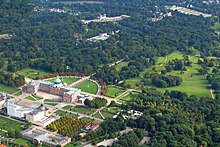 Aerial view of Sanssouci Park
Aerial view of Sanssouci Park
Sanssouci Palace
- 2 Sanssouci Palace (Sanssouci), Sanssouci Palace, Maulbeerallee, 14469 Potsdam. Tel.: 49 331 9694-200, Fax: 49 331 9694-107, Email: [email protected]. The Sanssouci Palace was built between 1745 and 1747 based on a sketch by Frederick the Great by G.W. built by Knobelsdorff. It stands on the plateau of the so-called Terrace of Sanssouci, a 20 m high hill with a lovely view. The main building, 97 m long and 15 m deep, is only one storey high and has a small curve with a niche on the wings, in the middle of the front facing the garden a flat rounded curve with a dome supported by colossal caryatids , and on the other front, facing the mountain of ruins, a semicircle colonnade of 88 Corinthian columns. Guided tours and visits with audio guides are offered in several languages.Open: Tue-Sun 10 a.m.-5 p.m. (Nov-Dec 2017), Tue-Sun 10 a.m.-4.30 p.m. (Jan-Mar 2018), Tue-Sun 10 a.m.-5.30 p.m. (Apr-Oct 2018).Price: regular: 12, - €, reduced: 8, - €, Sanssouci (all castles on one day) regular: 19, - €, reduced: 14, - €, photo permission day ticket (valid for all castles): 3, - €.Accepted payment methods: Master, Visa.
 Music room in Sanssouci Palace
Music room in Sanssouci Palace
New palace
- 3 New palace, Neues Palais, Am Neuen Palais, 14469 Potsdam (shortest walk from the Sanssouci train station). Tel.: 49 331 9694-200, Fax: 49 331 9694-107, Email: [email protected]. The magnificent New Palais is located at the western end of the Sanssouci Park, built between 1763 and 1769, under Frederick the Great immediately after the end of the Seven Years' War. It is the triumphant expression of the final link between Silesia (the pearl from the Habsburg crown) and Prussia. Emperor Friedrich (III.) Was born in the Neues Palais and died there of throat cancer in 1888 ("Dreikaiserjahr") after only 99 days of reign. Therefore, the Neues Palais was briefly named "Friedrichskron" after him. On July 31, 1914, his son, Kaiser Wilhelm II, signed the declaration of the state of war of the German Empire in the New Palais - de facto the beginning of the First World War for Germany! Like many other places in Potsdam, the New Palais "breathes" German history.Open: Wed-Mon 10 a.m.-5 p.m. (Nov-Dec 2017), Wed-Mon 10 a.m.-4.30 p.m. (Jan-Mar 2018), Wed-Mon 10 a.m.-5.30 p.m. (Apr-Oct 2018).Price: regular: 8, - €, reduced: 6, - €, Sanssouci (all castles on one day) regular: 19, - €, reduced: 14, - €, photo permission day ticket (valid for all castles): 3, - €.Accepted payment methods: Master, Visa.
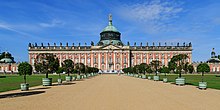 New palace
New palace
Charlottenhof Palace
- 4 Charlottenhof Palace, Charlottenhof Palace, Geschwister-Scholl-Strasse 34a, 14471 Potsdam (next access via train station or tram stop Charlottenhof). Tel.: 49 331 9694-200, Fax: 49 331 9694-107, Email: [email protected]. Charlottenhof Palace is located southwest of Sanssouci. It was the summer residence of Crown Prince Friedrich Wilhelm (1795-1861), who from 1840 was King Friedrich Wilhelm IV of Prussia.Open: Tue-Sun 10 am-5:30pm (May-Oct 2018).Price: regular: 6, - €, reduced: 5, - €, Sanssouci (all castles on one day) regular: 19, - €, reduced: 14, - €, photo permission day ticket (valid for all castles): 3, - €.Accepted payment methods: Master, Visa.
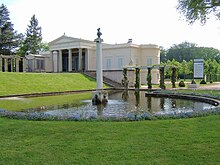 Charlottenhof Palace
Charlottenhof Palace
Orangery Castle
- 5 Orangery Castle, Orangery Palace, An der Orangerie 3-5, 14469 Potsdam. Tel.: 49 331 9694-200, Fax: 49 331 9694-107, Email: [email protected]. The 298 m long orangery castle is a building completed in 1856, the central body of which forms a richly structured atrium with vestibule, on the roof of which two tower-like superstructures rise. In the very richly decorated room of this main part there is a Raphael gallery, that is, a collection of meticulous copies of 45 of the master's most famous paintings. The long side buildings, adorned with 16 marble statues in niches, are intended to overwinter the large collection of orange trees that decorate the terraces in front of the castle during the summer. The marble statue of Friedrich Wilhelm IV (von Bläser, 1873) stands in front of the pillared courtyard of the orangery.Open: Sat-Sun 10 am-5:30pm (Apr 2018), Tue-Sun 10 am-5:30pm (Mar-Oct 2018).Price: regular: 6, - €, reduced: 5, - €, Sanssouci (all castles on one day) regular: 19, - €, reduced: 14, - €, photo permission day ticket (valid for all castles): 3, - €.Accepted payment methods: Master, Visa.
 Orangery Castle
Orangery Castle
Chinese house
- 6 Chinese house, Chinese house in Sanssouci Park, Am Grünenänke, 14469 Potsdam. Tel.: 49 331 9694-200, Email: [email protected]. The Chinese House, also known as the Chinese Tea House, is a garden pavilion in Sanssouci Park in Potsdam. Frederick the Great had the building erected around seven hundred meters southwest of the Sanssouci summer palace to decorate his ornamental and kitchen gardens. The master builder Johann Gottfried Büring was commissioned with the planning, who, based on the king's sketches, created a pavilion in the style of the Chinoiserie between 1755 and 1764, a mixture of ornamental style elements from the Rococo and parts of East Asian designs.Open: Tue-Sun 10 am-5:30pm (May-Oct 2018).Price: regular: 4, - €, reduced: 3, - €, Sanssouci (all castles on one day) regular: 19, - €, reduced: 14, - €, photo permission day ticket (valid for all castles): 3, - €.Accepted payment methods: Master, Visa.
 Chinese house
Chinese house
Historic mill
- 7 Historic mill of Sanssouci (Historic windmill). Tel.: 49 331 9694-200, Fax: 49 331 9694-107, Email: [email protected]. To the west of the castle stands the anecdotal 9 windmill, which burned down during the fighting in 1945, but was rebuilt in 1989 (reopening for the 1000th anniversary of Potsdam in 1993).Open: Sat-Sun 10-16 (Jan-Mar 2018), Mon-Sun 10-18 (Apr-Oct 2018).Price: regular: 4, - €, schoolchildren / students / trainees: 3, - €, children 6-14 years 2, -. €, children 0-5 years free entry, Sanssouci (all castles on one day) regular: 19, - €, reduced: 14, - €, photo permit day ticket (valid for all castles): 3, - €.Accepted payment methods: Master, Visa.
further sights in the Park Sanssouci
Other smaller but interesting buildings in the park include the 8 Friendship stamp with the statue of the Margravine of Bayreuth, the sister of Frederick the Great, the 9 Kaiser Friedrich Mausoleum with graves of Prussian rulers and the 10 Neptune's grotto with shell and others more.
New garden
- 11 New garden Potsdam, New Garden, Am Neuen Garten, 14469 Potsdam. Tel.: 49 331 9694-200, Fax: 49 331 9694-107, Email: [email protected]. The New Garden covers 102.5 hectares and is the third largest garden monument in Potsdam. It almost completely encloses the Holy Lake and borders the Jungfernsee. Friedrich Wilhelm II. Had a new garden laid out on this area from 1787, which was to stand out from the baroque Sanssouci Park. In the New Garden there are numerous other sights that are also part of the world heritage, first and foremost the Cecilienhof Palace. In contrast to Sanssouci, the New Garden is used by Potsdamers for local recreation. In addition to a number of official and unofficial sunbathing lawns, there is a (nudity) bathing area that is very popular with Potsdam residents - to the annoyance of the monument protectors - which has so far successfully withstood all attempts to ban it.Open: all year round from 8 a.m. until dark.Price: free entry, donation possible.
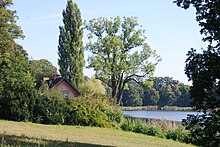 The New Garden with a view of the Holy Lake
The New Garden with a view of the Holy Lake
Cecilienhof Palace
- 12 Cecilienhof, Cecilienhof Palace, Im Neuen Garten 11, 14469 Potsdam. Tel.: 49 331 9694-200, Fax: 49 331 9694-107, Email: [email protected]. The second most famous palace after Sanssouci is Cecilienhof Palace, where the Potsdam Conference met in 1945. A memorial was dedicated to the event. You can also visit the apartments of the last German or Prussian crown prince couple, for whom the castle was built from 1914 to 1917. The castle is in the English country house style.Open: Tue-Sun 10 a.m.-5 p.m. (Nov-Dec 2017), Tue-Sun 10 a.m.-4.30 p.m. (Jan-Mar 2018), Tue-Sun 10 a.m.-5.30 p.m. (Apr-Oct 2018).Price: Venue of the Potsdam Conference regular: € 8, reduced: € 6, private rooms of the Crown Prince couple regular: € 6, reduced € 5, combination ticket Cecilienhof & Marble Palace regular: € 10, reduced: 7 , - €, Sanssouci (all castles on one day) regular: 19, - €, reduced: 14, - €, photo permission day ticket (valid for all castles): 3, - €.Accepted payment methods: Master, Visa.
 Cecilienhof Palace
Cecilienhof Palace
Marble palace
- 13 Marble palace, Marble Palace, Im Neuen Garten 10, 14469 Potsdam. Tel.: 49 331 9694-200, Fax: 49 331 9694-107, Email: [email protected]. The marble palace built by Friedrich Wilhelm II in the years 1787–1793 is located close to the shore of the Holy See. The architects Carl von Gontard and from 1790 the builder of the Brandenburg Gate in Berlin, Carl Gotthard Langhans, created a palace building in the style of early classicism.Open: Sat-Sun 10 am-4pm (Jan-Mar 2018), Sat-Sun 10 am-5:30pm (April), Tue-Sun 10 am-5:30pm (May-Oct 2018).Price: regular: 6, - €, reduced: 5, - €, combination ticket Cecilienhof & Marmorpalais regular: 10, - €, reduced: 7, - €, Sanssouci (all castles on one day) regular: 19, - €, reduced : € 14, photo permission day ticket (valid for all castles): € 3.Accepted payment methods: Master, Visa.
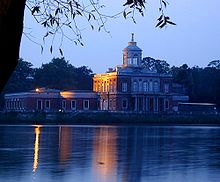 Marble palace
Marble palace
further sights in the new garden


Other sights in the New Garden include the 14 Gothic library, which King Friedrich Wilhelm II used as his personal library and on the south of the Heiliger See. The building cannot be entered, but the basement can be seen through the window fronts. Behind Schloss Cecilienhof near the Jungfernsee lies the so-called 15 Shell grotto. It was also commissioned by Friedrich Wilhelm II and served as a residence for tea parties. Heute kümmert sich der Verein Förderkreis der Muschelgrotte im Neuen Garten um die Pflege und den Erhalt des Bauwerks, bei dem nach Voranmeldungen Besichtigungen vereinbart werden können (E-Mail: [email protected]). Letztlich ist noch der pyramidenförmige 16 Eiskeller von Friedrich Wilhelm II. nennenswert. Dieser befindet sich nördlich in der Sichtachse des Marmorpalais und diente zum Frischhalten von Lebensmitteln. Im Winter wurde dem nahen Heiligensee Eis entnommen und in der untersten Etage des circa fünf Meter in den Boden gehenden Kellers gelagert. Heute kann man ihn nur noch von außen besichtigen. Ein Ausflug zu dieser untypischen Sehenswürdigkeit ist trotzdem lohnenswert.
Schloss Belvedere auf dem Pfingstberg
Westlich des Neuen Gartens liegt der 76 m hohe 17 Pfingstberg mit dem Schloss Belvedere. Man kann ihn zu Fuß gut vom Neuen Garten oder von der Alexandrowka aus erreichen. Während der DDR-Zeit war der Pfingstberg Sperrgebiet, im angrenzenden Villenviertel an den Ufern des Jungfernsees lebten Angehörige der Roten Armee. Für viele alteingesessene Potsdamer ist die Zugänglichkeit des Pfingstberg daher bis heute ein Symbol der neu gewonnenen Freiheiten. So ist die öffentliche Empörung zu verstehen, als Mathias Döpfner, Top-Manager im Axel Springer Verlag, die von ihm auf dem Pfingstberg erworbene 18 Villa Henckel per Zaun für die Öffentlichkeit absperrte. Erst nach längeren Verhandlungen mit der Stadtverwaltung konnte ein Kompromiss gefunden werden, der zumindest eine Teilzugänglichkeit des zur Villa gehörenden Parks vorsieht.
- 19 Belvedere auf dem Pfingstberg, Belvedere Pfingstberg, Pfingstberg, 14469 Potsdam. Tel.: 49 331 9694-200, Fax: 49 331 9694-107, Email: [email protected]. Das Belvedere auf dem Pfingstberg ist ein Aussichtsschloss, das 1862/63 vollendet wurde. Initiator war Friedrich Wilhelm IV., der 1828 die architektonischen Anregungen von seiner Reise nach Rom mitbrachte. Der Bau konnte jedoch erst nach Friedrich Wilhelms Tod von seinem Bruder Wilhelm I. in verkleinerter Ausführung fertiggestellt werden. Bis vor dem Zweiten Weltkrieg war Belvedere ein beliebtes Ausflugsziel. Aufgrund der nahen Grenzlage wurde das Schloss in den 1950er Jahren allerdings gesperrt und verfiel. Erst nach der Wende von 1990 setzten Bemühungen ein, das Bauwerk zu erhalten. 2005 konnte die Sanierung des Bauwerks abgeschlossen werden. Von den Türmen des Belvedere hat man aus 103 m Höhe eine schöne Rundsicht. Über dem Grunewald ist bei guter Sicht die Silhouette der Stadt zu sehen. In den Sommermonaten finden vor der romantischen Kulisse des Belvedere vielfältige kulturelle Veranstaltungen statt.Geöffnet: Sa-So 10-16 (Nov 2017), Sa-So 10-16 (Mrz 2018), täglich 10-18 (Apr-Okt 2018).Preis: regulär: 4,50 €, ermäßigt: 3,50 €, Kinder 6-16 Jahre: 2,- €, Kinder 0-5 Jahre: Eintritt frei, Familienkarte (2 Erwachsene 3 Kinder bis 17 Jahre): 12,- €, Kombiticket Schloss Cecilienhof regulär: 10,- €, ermäßgt: 7,- €, Kombiticket Museum Alexandrowka regulär: 6,- €, ermäßigt 5,- €, Inhaber des Kombitickets Sanssouci erhalten den ermäßgten Preis.Akzeptierte Zahlungsarten: Master, Visa.
Russische Kolonie Alexandrowka

The 20 Russische Kolonie Alexandrowka besteht aus mehreren Holzhäusern mit umgebenden Wirtschaftsgärten, die in den Jahren 1826 und 1827 auf Wunsch des preußischen Königs, Friedrich Wilhelm III., im russischen Stil erbaut wurden. Die Anlage wurde in Gedenken an den verstorbenen russischen Zar Alexander I. errichtet und diente als Heim der russischen Sänger des ersten preußischen Garderegiments. Die weitläufigen Wirtschaftsgärten mit Obstplantagen um jedes Haus wurden von Peter Joseph Lenné entworfen und dienten sowohl zur Versorgung der Siedler als auch zur Bewerbung der neuen Landwirtschaftspolitik. Im Jahr 1999 nahm die UNESCO die Alexandrowka in das Welterbe auf, das heute im Eigentum der Stadtverwaltung ist. Die meisten der 13 Koloniehäuser sind heute ganz normal bewohnt. In der Hausnummer 2 befindet sich das Museum Alexandrowka, im Haus in der Mitte des Kreuzwegs (Nr. 1) befindet sich eine Gastronomie, das 1 Russische Teehaus. Etwas nördlich der Kolonie schließt sich der Kapellenberg an, auf dem eigens für die Kolonisten die von Friedrich von Schinkel entworfene 21 Alexander-Newski-Gedächtniskirche errichtet wurde. Als Grundlage für den Kirchenbau diente eine Vorlage der nicht mehr existierenden Desjatin-Kirche in Kiew. Man erreicht die Alexandrowka sehr gut mit den Tram-Linien 92 oder 96, Haltestelle Puschkinallee.
- 22 Museum Alexandrowka, Museum Alexandrowka, Russische Kolonie 2, 14469 Potsdam (etwa in der Mitte des nordwestlichen Kreuzweg durch die Kolonie). Tel.: 49 331 8170203, Email: [email protected]. Das Museum Alexandrowka wurde 2005 eröffnet und befindet sich in einem der historischen Siedlungshäuser. Das Gebäude aus dem 1826 wurde 2001 liebevoll restauriert. Das Museum zeigt in sechs Räumen eine Dauerausstellung zur Geschichte der Russischen Kolonie. Neben historischen Exponaten können zwei etwa 30minütige Filme angeschaut werden. Im nach historischen Vorbild wieder hergestellten Garten befindet sich ein kleines Café mit 40 Sitzplätzen.Preis: regulär: 3,50 €, ermäßigt: 3,- €, Kinder unter 14 Jahre in Begleitung der Eltern haben freien Eintritt; Gruppen werden um Voranmeldung gebeten.
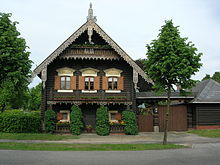 Museum Alexandrowka
Museum Alexandrowka
Sehenswürdigkeiten in Babelsberg
Park und Schloss Sacrow
The 23 Park Sacrow ist der kleinste und und etwas verwunschen wirkende Welterbepark in Potsdam. Seine Lage am Nordufer des Jungfernsee macht ihn von Potsdam aus über Land umständlich zu erreichen, entsprechend zieht er mit Abstand die wenigsten Besucher an. Diese außerordentlich reizvolle Lage war auch der Grund, warum König Friedrich Wilhelm IV. Sacrow 1840 gleich nach seiner Thronbesteigung erwarb. Dem Gartenkünstler Peter Joseph Lenné erteilte er den Auftrag, das Areal landschaftlich zu gestalten. Der Park ist ganzjährig von 8 Uhr bis Einbruch der Dunkelheit geöffnet. Am einfachsten (und schönsten) ist der mit dem Potsdamer Wassertaxi zu erreichen.
Der König ließ 1844 nach Plänen von Ludwig Persius die weithin übers Wasser sichtbare 24 Heilandskirche auf der in den Jungfernsee ragenden Landspitze im italienischen Stil mit freistehendem Campanile (Glockenturm) errichten.
- 25 Schloss Sacrow, Schloss Sacrow, Krampnitzer Straße 33, 14469 Potsdam. Tel.: 49 331 9694-200, Fax: 49 331 9694-107, Email: [email protected]. Das Schloss Sacrow wurde wurde 1773 von dem schwedischen Generalleutnant Johann Ludwig von Hordt erbaut und in den später geschaffenen königlichen Garten Sacrow integriert. Das streng im Barockstil errichtete Gebäude weist als Besonderheit ein Gewächshaus am Südgiebel auf. Das Anwesen wechselte mwehrfach den Besitzer, unter anderem verbrachte der Dichter Friedrich de la Motte Fouqué hier einige Jugendjahre und wurde zu seiner Undine inspiriert. Felix Mendelssohn Bartholdy komponierte hier wahrscheinlich Teile seines Streichquartetts in a-moll. Nach Errichtung der Heilandskirche wurde im Schloss zusätzlich die Amtswohnung des Pfarrers eingerichtet.Geöffnet: nur im Rahmen von Sonderausstellungen geöffnet.
 Schloss Sacrow
Schloss Sacrow
Jagdschloss Stern
- 26 Jagdschloss Stern, Jagdschloss Stern, Jagdhausstraße 32, 14480 Potsdam (Tram 96 bis H Gaußstraße, von dort 5min Fußweg). Tel.: 49 331 9694-200, Fax: 49 331 9694-107, Email: [email protected]. Das Jagdschloss Stern wurde von 1730 bis 1732 unter Friedrich Wilhelm I. im Stil eines schlichten holländischen Bürgerhauses errichtet. Es war zwar der einzige Schlossbau des Soldatenkönigs in Potsdam, diente aber als Vorbild für die spätere Errichtung des Holländerviertels. Das Gebäude ist nahezu vollständig im Original erhalten, inklusive Holztäfelung und Innenausstattung. Zum Schlossgelände gehören weitere Nebengebäude, wie Kastellanhaus oder der Pferdestall. Das nur für Jagdaufenthalte konzipierte Gebäude stand bei seiner Erbauung im Mittelpunkt eines weitläufigen Geländes, das seit 1726 mit der Anlage eines sternförmigen Schneisensystems für Parforcejagden erschlossen wurde. Heute steht es am Rand des bevölkerungsreichsten und von DDR-Plattenbauarchitektur beherrschten Stadtteils Am Stern, die A115 verläuft nur wenige Meter hinter dem Welterbe.Geöffnet: nur im Rahmen von Sonderveranstaltungen geöffnet.
Das Alte Potsdam
Nördliche Innenstadt (Altstadt)
Das heute als Nördliche Innenstadt bezeichnete Viertel entspricht dem historischen Potsdam. Es umfasst im Südosten entlang der Havel das Gebiet zwischen Neustädter Bucht und Humboldtbrücke und wird im Nordwesten in etwa von der Kurfürstenstraße, der Hegelallee und Schopenhauerstraße begrenzt. Der älteste, bereits im Mittelalter besiedelte Teil liegt dabei an der Havel, gegenüber der Freundschaftsinsel, der Abschnitt nördlich der Charlottenstraße entstand später als planvoll angelegte barocke Stadterweiterung. Unmittelbar im Westen schließt sich der Welterbe-Park Sanssouci an beziehungsweise im Norden der Neue Garten. Die Nördliche Innenstadt wird von vielen Touristen also zwangsläufig durchquert, bietet aber selbst eine ganze Reihe von Sehenswürdigkeiten, Museen sowie eine attraktive Einkaufsmeile. Es empfiehlt sich unbedingt die historische Innenstadt zu Fuß zu erkunden. Einerseits ist aufgrund der Verkehrsführung und gezielt verknappter Parkplätze der Zugang mit dem Pkw weder einfach noch sinnvoll, aber auch mit dem Fahrrad wird man auf dem vielfach verlegten historischen Kopfsteinpflaster wenig Freude haben.
Freundschaftsinsel
Wer vom Hauptbahnhof aus die Lange Brücke überquert, steht etwa auf halber Strecke am Zugang zur Freundschaftsinsel, die vollständig von einem schön gestalteten Park eingenommen wird. Im Mittelalter (damals noch unter dem Namen Communication) diente sie zur Sicherung des Flußübergangs und war mit Wehrtürmen bestückt. Seit dem 19. Jahrhundert entwickelte sie sich zunehmend zum Ausflugsziel, 1937-1940 legte Karl Foerster dort einen Lehrgarten an. Im Zweiten Weltkrieg schwer beschädigt, wurde die Gartenanlage in den 1950er und dann noch einmal in den 1970er ausgebaut. Im Zuge der Bundesgartenschau erfolgte 2001 die letzte Modernisierung. Der Park ist grob in drei Teile gegliedert: direkt an der Langen Brücke befindet sich eine Liegewiese, die vor allem von jungen Leuten genutzt wird. Dahinter und von einem eigenen Zaun umgeben ist der Botanische Garten, zu dem auch ein Kunsthaus und das Inselcafé belong. Der nördliche Teil der Insel beherbergt einen großen, 2018 runderneuerten Spielplatz mit Wasserspielplatz, einen Tretbootverleih sowie einen Panoramapunkt mit Blick auf Humboldtbrücke und Tiefer See. Direkt am Spielplatz befindet sich der einzige weitere Zugang, die zur Altstadt führende Inselbrücke. Neben dem engagierten Inselgärtner Thoralf Götsch kümmert sich der Verein "Freunde der Freundschaftsinsel e.V." liebevoll um die Pflege und den Erhalt. Besonders im Sommer werden immer wieder Feste und Kulturprogramm auf der Insel geboten. Auf der Insel finden sich viele Plastiken und Kunstwerken, von Künstlern aus der DDR ebenso wie aus der Zeit nach 1990.
- 27 Freundschaftsinsel, Lange Brücke, 14467 Potsdam. Geöffnet: Mo-So, 7 Uhr bis Einbruch der Dunkelheit.Preis: kostenfrei (Festen kosten ggf. Eintritt).
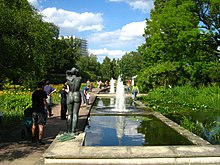 Der Botanische Garten auf der Freundschatsinsel
Der Botanische Garten auf der Freundschatsinsel - 28 Ausstellungspavillon Freundschaftsinsel (Pavillon), Freundschaftsinsel, 14467 Potsdam (im Botanischen Garten auf der Freundschaftsinsel). Tel.: 49331279753980. Geöffnet: April-September Mi-So 13-18 Uhr; Oktober-März Mi-So 13-17 Uhr.Preis: frei.
Alter Markt
The 29 Alte Markt ist das ursprüngliche Zentrum der Stadt. Auch dort führte der Bombenangriff von 1945 zu einer weitgehenden Zerstörung des historischen Stadtraums. Das ursprünglich dort stehenden Stadtschloss der Hohenzollern sowie die meisten der umstehenden Gebäudensembles wurden dabei schwer beschädigt. In der DDR-Zeit wurden lediglich die Nikolaikirche, das Alte Rathaus und das dazugehörige Knobelsdorffhaus sowie der auf der Platzmitte stehende Obelisk restauriert. Alle weiteren Gebäudereste am Platz wurden abgerissen. In den 1970ern entstanden schließlich Lehrgebäude (später für die FH Potsdam genutzt) sowie Wohnbebauung ("Staudenhof") im Plattenbaustil. Noch 1989 wurde der Grundstein für den neuen Standort des Hans-Otto-Theaters gelegt, das Gebäude aber nie fertiggestellt. Bereits 1991 erfolgte dessen Abriss und in der Folge Schritt für Schritt die Wiederannäherung an die Platzgestaltung vor dem Zweiten Weltkrieg. So wurde zunächst der neue Brandenburger Landtag mit historisierender Fassade am Standort alten Stadtschlosses errichtet.
Für viele Potsdamer selbst ist der Alte Markt heute ein im Lebensalltag wenig genutzter Platz, mit eher geringer Aufenthaltsqualität, gesäumt von Sehenswürdigkeiten. Er wird derzeit vor allem Touristen aufgesucht, Potsdamer durchqueren den eher leeren Platz vor allem auf der Strecke zwischen Hauptbahnhof und Einkaufsinnenstadt. Mit dem Abriss des alten Fachhochschulgebäudes am Alten Markt im Jahr 2018 und dem geplanten Bau eines Wohn- und Einkaufsquartiers mit teils rekonstruierten Fassaden bis 2022 wird sich dies möglicherweise ändern.
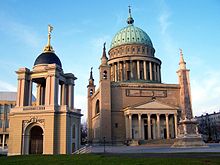
Wichtigster Sakralbau ist die 30 St. Nikolaikirche am alten Markt. 1837 beginnen unter der Leitung des Baumeisters Friedrich Ludwig Persius beginnen die Arbeiten an der Kirche. Erst 1843 wird nach den ursprünglichen Plänen Schinkels die Tambourkuppel aufgesetzt. Die Einweihung der Kirche in ihrer endgültigen, das Stadtbild prägenden Architektur findet am 24. März 1850 statt. Schon die Ausmaße des Bauwerks zeigen, dass die Nikolaikirche aus bautechnischer Sicht ein bemerkenswertes Baudenkmal darstellt. Die Gesamthöhe bis zum Kreuz beträgt 77 m. Das Hauptgesims des quadratischen Unterbaues liegt in 27 m Höhe. Darauf erhebt sich der von 28 Säulen umstellte Tambour mit einer Höhe von 22,5 m. Die Kuppel selbst hat bei einem Durchmesser von 24 m eine Höhe von 13 m und trägt wiederum eine Laterne mit Kreuz, die 14,5 m hoch ist. Es ist möglich den Kuppelring zu besteigen. Für 5 € (2019) kann man sich über enge Wendeltreppen nach oben schrauben und einen schönen Blick über die Stadt genießen. An kalten Tagen sollte man Jacke und Mütze nicht vergessen, es zieht.
Auf der Südseite des Platzes, auf einem Grundstück zur Havel hin, ist in den Jahren 2014 bis 2016 das Palais Barberini wieder erbaut worden, eine Bürgervilla mit klassizistischer Fassade. Im 2. Weltkrieg zerstört, war hier lange Zeit eine Brachfläche und der Wiederaufbau lange Zeit umstritten. Im wiederentstandenen Palais ist nunmehr das
- 31 Museum Barberini, Alter Markt (Humboldtstr. 5–6), 14467 Potsdam. untergebracht, das Sonderausstellungen, aktuell "Klassiker der Moderne" und Kunst aus der DDR-Zeit aus der Sammlung des Software-Unternehmers Hasso Plattner zeigt.Geöffnet: Mi bis Mo 11-19, Do bis 21, Di geschlossen.Preis: 14 Euro, ermässigt 10.
The 32 Potsdamer Filmmuseum ist das älteste Filmmuseum Deutschlands und befindet sich im historischen Marstall des ehemaligen Stadtschlosses. Es bietet mit seiner ständigen Ausstellung "Babelsberg - Gesichter einer Filmstadt" einen Einblick in die Geschichte der legendären Babelsberger Filmstudios. Über 700 originale Filmrequisiten der Ufa-, DEFA- und heutigen Studios können wiederentdeckt werden. Zusätzlich gibt es attraktive Sonder- und Familienausstellungen zur weiten Welt des Films, Kino mit den Glanzstücken der internationalen Filmkunst und Stummfilme, begleitet an der Welte-Kinoorgel. Die Sammlungen zu den Babelsberger Filmstudios beherbergen über eine Million Fotos, Filmtechnik, Kostüme und Nachlässe bekannter Stars. Diese Schätze können nach Anmeldung besichtigt werden.Opening hours: Museum: täglich 10 - 18 Uhr, Kino: Mo- Do, So 18, 20 Uhr, Fr, Sa 18, 20, 22 Uhr, Kinderkino: Mi, Sa, So 16 Uhr, ab Januar 2010 (Museum) / Februar 2010 (Kino), montags geschlossen, Entry: Museum: 3,50 bis 6,00 € / erm.: 2,50 bis 4,00 €, zzgl. 1 € mit Führung, Familienkarte: 10 bis 12 €, Kino: 5 €/ 4 € erm., Mo - Kinotag: 3 €, Kinderkino: 2,50 €
Ebenfalls fußläufig vom Alten Markt erreichbar ist das Extavium. Dort können Kinder viele physikalische Experimente selbst ausprobieren (ehem. Exploratorium) Extavium. Am Kanal 57, 14467 Potsdam, Tel. 0331 60127959 Opening hours: Di-Fr 8.30-18 Uhr, Sa So 10-18 Uhr (während der Schulferien Di-Fr erst ab 10 Uhr) Entry: 6,40 € / Kinder 4,80 € / Familienkarte für 2 Erwachsene und max. 3 Kinder 20 €
Barocke Stadterweiterung

Am Luisenplatz in Potsdam steht das kleine33 Brandenburger Tor, erbaut 1770 nach dem Siebenjährigen Krieg. Von hier zieht sich die Brandenburger Straße nach Osten bis zur Kirche Peter und Paul, in der näheren Umgebung des Tores findet man zahlreiche typische Altstadthäuser, es gibt Cafés und Restaurants, hier findet man auch eine Tourist-Information. Unter dem Luisenplatz befindet sich eine Tiefgarage, und auf der Nordseite des Platzes beginnen die Stadtrundfahrten der Busse.
Holländisches Viertel und Bassinplatz

Im Herzen Potsdams liegt das 34 Holländische Viertel, welches im 18. Jahrhundert unter Leitung des holländischen Baumeisters Johann Boumann erbaut wurde, um holländische Handwerker nach Potsdam zu locken. Es gilt als größtes zusammenstehendes Bauensemble und Kulturdenkmal holländischen Stils außerhalb der Niederlande in Europa.
Mercure und Lustgarten
Wer die Lange Brücke vom Hauptbahnhof kommend überquert, läuft direkt auf ein 17-stöckiges Hochhaus aus DDR-Zeiten zu, das heutige Hotel Mercure. Früher ein vielgerühmtes Interhotel mit legendärem Café und einmaligen Blick aus dem obersten Stock, führt eine internationale Hotelkette heute den Betrieb fort. Das Café befindet sich mittlerweile weit weniger spektakulär in der Lobby, allerdings gibt es seit einigen Jahren Überlegungen, im obersten Stock erneut eine Gastronomie einzurichten, diesmal als moderne Rooftop-Bar. Direkt neben dem Hotel ist der Anlegeplatz der Weißen Flotte sowie der Lustgarten mit teilweise wieder restauriertem Neptun-Bassin. Zwischen Lustgarten und Breiter Straße befindet sich der Festplatz, auf dem Jahrmärkte und ähnliche Veranstaltungen stattfinden.
- 35 Lustgarten (Potsdam), Breite Straße, 14467 Potsdam. Preis: frei.
- 36 Neptunbrunnen (Neptunbassin). Preis: frei.
Plantage, Garnisonkirche und Rechenzentrum
Wer dem Verlauf der Breiten Straße über die Lange Brücke vom Bahnhof kommend folgt, erreicht an der Kreuzung Yorckstraße ein Areal das wohl wie kein zweites für die teils sehr hitzig geführten Debatten um Stadtentwicklung und den Umgang mit dem historischen Erbe der Stadt, von Kaiserzeit bis DDR, steht. Zu Kaisers Zeiten bildete dort die Parkanlage Plantage, die Kavalleriekaserne Langer Stall und die monumentale Militärkirche Garnisonkirche entlang des historischen Stadtkanals ein Ensemble, das geradezu Beispielhaft für das (Selbst-)Bild des kaiserlichen Preußens steht. Im Zweiten Weltkrieg war das Areal schwer von der Bombardierung am 14. April 1945 betroffen. Vom Stall blieb nur die kurze Gebäudefront in Richtung Breiter Straße stehen, der historische Stadtkanal wurde 1945 mit Kriegsschutt aufgefüllt. Die Garnisonkirche, ebenfalls schwer beschädigt, blieb zunächst stehen, bis dann im Jahr 1968 die DDR-Regierung die Sprengung und den Abriss verfügte. Bereits 1971 wurde auf dem Gelände, neben einer verkleinerten und neu gestalteten Plantage, ein für seine Zeit moderner DDR-Bau, das Rechenzentrum, mit angrenzender Rechnerhalle und Parkplatz errichtet. Sdchon bald nach der Wiedervereinigung entbrannten Debatten über den Umgang mit dem Areal, die bis heute fortdauern und in großer Schärfe geführt werden. Etwas verkürzt stehen sich dabei eine nach dem Vorbild der Dresdner Frauenkirche gegründete Wiederaufbau-Stiftung gegenüber, die die Garnisonkirche und ihr Umfeld am liebsten in den Zustand der Kaiserzeit rekonstruieren möchte. Ihr gegenüber findet sich eine bunte Koalition, der der Wiederaufbau kaiserlicher Herrschaftssymbole ebenso wenig behagt, wie der ruppige Umgang mit dem architektonischen Erbe der DDR und eine Stadtentwicklung, die Potsdam die höchsten Mieten in ganz Ostdeutschland beschert hat. Die Auseinandersetzung wird mir harten Bandagen und sehr persönlich geführt, Politik und Verwaltung zeigen sich weitgehend überfordert mit dem Konflikt. Aktuell wird der Turm der Garnisonkirche wieder errichtet, während es für das zum Kunst- und Kreativzentrum umgenutzten Rechenzentrum noch eine Bestandsgarantie bis 2023 gibt.
- Plantage (Glockenplatz), Die Plantage, Dortustraße, 14467 Potsdam. Die Plantage ist eine Parkanlage an historischem Ort, ohne das derzeit ein allzugroßer Reiz von ihr ausginge. Auf dem Gelände ist seit einigen Jahren das Glockenspiel aus der Garnisonkirche aufgestellt, das zu jeder vollen Stunde die Melodie "Lobe den Herren" und zu jeder halben Stunde das Lied "Üb immer Treu und Redlichkeit" spielt. In den Jahren 2019/20 soll die Plantage durch den Abriss der benachbarten Rechnerhalle und des Parkplatzes erweitert und neu gestaltet werden.
- 37 Garnisonkirche, Breite Straße 7, 14467 Potsdam. Tel.: 49 331 20 11 830. Der Turm der Garnisonkirche wird aktuell rekonstruiert. Direkt neben der Baustelle befindet sich die Nagelkreuzkapelle mit kleinem Informationszentrum der Stiftung Garnisonkirche zum Nachbauvorhaben. Gelegentlich finden dort Gottesdienste und Veranstaltungen die für den Wiederaufbau werben statt. Die Gegner einer Wiedererrichtung betreiben einen Blog (https://ohnegarnisonkirche.wordpress.com/), in dem sie ihre Argumente und ggf. Termine zu Veranstaltungen gegen das Vorhaben veröffentlichen.Geöffnet: Di-So 11-17 Uhr.Preis: frei.
- 38 Langer Stall, Breite Straße, 14467 Potsdam. Vom abgebrannten Langen Stall steht heute nur noch das Portal von 1781, das 1983/84 restauriert wurde. Auf der restlichen Fläche des ehemaligen Langen Stalls soll in den kommenden Jahren Wohnbebauung entstehen.
- Mosaik am Rechenzentrum (“Der Mensch bezwingt den Kosmos”), Dortustraße 46, 14467 Potsdam. Das von Fritz Eisel geschaffene Mosaik “Der Mensch bezwingt den Kosmos” zieht sich entlang der Fassade zu Breiter Straße und Dortustraße. Es zeigt die Errungenschaften der modernen Technik zu Beginn der 1970er Jahre, wie einen Kosmonauten oder frühe Computer, und ist ein sehenswertes Beispiel für öffentliche DDR-Kunst am Bau. Auch wenn der Erhalt im Fall des Abrisses außer Frage steht, ist noch völlig offen, ob und wo das Mosaik künftig zu sehen sein soll.
Nauener Vorstadt
Direkt angrenzend am Neuen Garten befindet sich auf halber Strecke zum Pfingstberg die Nauener Vorstadt. In der Leistikowstr. 1 befindet sich die 39 Gedenk- und Begegnungsstätte ehemaliges KGB-Gefängnis Potsdam. Das Gebäude wurde im August 1945 von der sowjetischen Besatzungsmacht besetzt und als Gefängnis der Spionageabwehr umgebaut. Heute soll es auf die bedrückende Realität gegenwärtiger Gewaltregimes hinweisen. Opening hours: Mai - Oktober jeweils Sa und So 11-17 h. Entry: frei.
Babelsberg
Groß Glieniecker See
Im Nordosten der Potsdamer Innenstadt liegen an der Grenze zum Ortsteil Kladow des Berliner Bezirks Spandau der fast 2 km lange Groß Glieniecker See und der 2,8 km lange Sacrower See.
Der nördliche Groß Glienicker See ist fast völlig umbaut. Auf der Westseite gibt es auf dem ehemaligen Patrouillenweg der DDR-Grenztruppen einen durchgängigen Uferweg. Im Nordosten und Südosten befinden sind zwei Badestellen, ansonsten ist das Ost-Ufer nicht zugänglich. Die Ostseite wurde nach Kriegsende von Groß Glienicke abgetrennt und die Siedlung "Wochenend West" gehört seitdem zum Spandau.
Glienicker Brücke und Schloss Glienicke (Berlin)

The 40 Glienicker Brücke verbindet das Brandenburgische Potsdam mit dem Stadtstaat Berlin. Zu DDR-Zeiten war die Glienicker Brücke kein gewöhnlicher Grenzübergang. Hier wurden Spione und Agenten des Kalten Krieges ausgetauscht. Aufgrund ihrer Abgeschiedenheit wurde die Grenzübergangsstelle auf der Brücke an drei Tagen der Jahre 1962, 1985 und 1986 für spektakuläre Austauschaktionen internationaler Agenten aus Ost und West genutzt.
Wer mehr über Geschichte und Geschichten der Glienicker Brücke wissen will, kann dies im 41 Museum Villa Schöningen nachholen. Die Villa wurde von privater Hand (Matthias Döpfner, Vorstand der Axel Springer AG und einem Partner) zu einem Museum umgestaltet und zum 20. Jubiläum des Mauerfalls im Jahr 2009 eingeweiht. Öffnungszeiten: Donnerstag und Freitag 11 - 18 Uhr, Samstag und Sonntag 10 - 18 Uhr Eintritt: 9,- €, ermäßigt 7,- €, Kinder unter 18 J. frei.
Bereits auf der Berliner Seite befindet sich in unmittelbarer Näher zur Glienicker Brücke das 42 Schloss Glienicke. Es war das Sommerschloss des Prinzen Carl von Preußen. Öffnungszeiten Apr. − Okt.: Di - So 10 − 18 Uhr, Nov. − März nur mit Führung Sa. So. 10 − 17 Uhr. Entry: 5,- €, ermäßigt: 4,- €.
Südlich zum Glienicker See liegt das Jagdschloss mit dem Jagdschlosspark. Der südöstlich angrenze Ortsteil Klein Glienicke gehört wiederum zu Potsdam.
Einsteinturm und Telegrafenberg

The Telegrafenberg ist eine 94 Meter hohe Erhebung im Südwesten Potsdams, die zum Saarmunder Endmoränenbogen gehört. Auf dem Berg wurden im 19. Jahrhundert mehrere Observatorien errichtet, heute befindet sich dort der 43 Wissenschaftspark Albert Einstein. Eine Außenbesichtigung des Turmes ist jederzeit möglich und sehr empfehlenswert. Opening hours: Mo-So 08:00-19:00 Uhr. Entry: frei. Gäste müssen sich am Eingang kurz anmelden.
The Einsteinturm ist zwischen 1919 und 1922 erbautes Observatorium im „Wissenschaftspark Albert Einstein“ auf dem Telegrafenberg in Potsdam, ein für seine Entstehungszeit revolutionäres Bauwerk des Architekten Erich Mendelsohn. Es wurde nach dem Nobelpreisträger für Physik des Jahres 1921 benannt. Hier sollte die Gültigkeit von Einsteins Relativitätstheorie experimentell bestätigt werden. Das Gebäude steht unter Denkmalschutz. Der Turm steht auf dem Gelände des Astrophysikalischen Instituts Potsdam. Führungen mit Vortrag werden nur nach Anmeldung beim Verein Urania Potsdam durchgeführt und ist auf wenige Besucher pro Führung begrenzt.
The 44 Große Refraktor (bekannt durch das TV-Intro der ZDF Wissenschaftssendung mit Harald Lesch) steht ebenfalls auf dem Telegrafenberg. Der 1899 eingeweihte Potsdamer Refraktor ist das viertgrößte Linsenteleskop der Welt und ein bedeutender Zeuge der feinmechanisch-optischen Fertigung der frühen astrophysikalischen Forschung an der Wende vom 19. zum 20. Jahrhundert.
Biosphäre Potsdam und Buga-Park
Das Tropenhaus 45 Biosphäre Potsdam zeigt mehr als 20.000 Pflanzen aus 350 verschiedenen Arten. In der Halle gibt es ferner frei fliegende Vögel und Schmetterlinge. Georg-Hermann-Allee 89, 14469 Potsdam. Opening hours: Mo - Fr: 9-18 Uhr (letzter Einlass 16:30 Uhr); Sa, So und Feiertage: 10-19 Uhr (letzter Einlass 17:30 Uhr). Entry: Normaltarif: 11,50 € ermäßigt: 9,80 € Kinder (5-13 Jahre): 7,80 €, Kleinkinder (3-4 Jahre): 4,50 €, Familienkarte (2 Erwachsene mit 3 Kindern): 33,50 €;
The Volkspark Potsdam (auch Buga-Park genannt) ebenfalls im Norden Potsdams wurde im Rahmen der Bundesgartenschau im Jahr 2001 auf 65 ha erweitert und mit vielen Gartenbauattraktionen ausgebaut. So gibt es einen Kletterspielplatz und einen Disc-Golf-Parcours. 46 Haupteingang Georg-Hermann-Allee 101, 14469 Potsdam. Opening hours: täglich 5-23 Uhr ggf. veränderte Öffnungszeiten bei Sonderveranstaltungen. Eintritt: Der Buga-Park ist kostenpflichtig / Sommertarif vom 1. März − 30. November: 1,- € / ermäßigt: 50 Cent. Wintertarif vom 1. Dez. − 28. Febr. generell: 50 Cent.
activities
Wassersport
Potsdam ist auf allen Seiten von Wasser umgeben. Neben der Havel, prägen die Nuthe, der Sacrow-Paretzer-Kanal sowie eine ganze Reihe von Seen (u. a. Griebnitzsee, Fahrländer See, Wannsee) die Landschaft und das Lebensgefühl in Potsdam. Dementsprechend bietet die Stadt insbesondere im Sommer zahlreiche Aktivitäten an, auf und im Wasser.
Freundschaftsinsel
Die Freundschaftsinsel bietet zwar keine Badestelle, allerdings einen schönen Wasserspielplatz für Kinder sowie einen Tretboot- und Kanuverleih an der Alten Fahrt.
- 1 Trebootverleih Freundschaftsinsel (Bootsvermietung Moisl), Lange Brücke, 14473 Potsdam (am Ufer der Alten Fahrt, östlich der Inselbrücke). Mobil: 491520-1688883, Email: [email protected]. Geöffnet: Mo-So 10-20 Uhr (nur Hauptsaison bei schönem Wetter).Preis: ab 10€/Std.
Regular events
- Weihnachtsmärkte im Advent
- Blauer Lichterglanz in der Potsdamer Innenstadt.
- Romantisches Weihnachtsdorf auf dem Krongut Bornstedt.
- Holländisches Sinterklaas-Fest im Holländischen Viertel.
- Böhmischer Weihnachtsmarkt auf dem Weberplatz Babelsberg.
- Adventsgarten in der Alexandrowka.
- Weihnachtsmarkt im Schloss Belvedere.
- Jarmarka – Russischer Weihnachtsmarkt
- Kieznikolausmarkt in Potsdam-West
- Adventszauber auf der Insel Hermannswerder
shop
The Fußgängerzone Potsdam bietet in der historischen Innenstadt nette Cafés und Modeboutiquen. The 1 Karstadt-Warenhaus verfügt über eine sehenswerte Buntglaskuppel. Brandenburger Straße 49-52, 14467 Potsdam.
- 2 Weekly market, Am Bassin 6, 14467 Potsdam. Spezialitäten wie Oliven, Schafskäse etc., frisches Obst und Gemüse gibt es täglich. Käse und andere Molkereiprodukte gibt es Mo, Mi, Do, Fr, Imbissangebote Mo, Di, Fr, Sa und Frischfisch Mo, Di, Sa.Geöffnet: Mo - Fr 07:00 - 16:00, Sa 7:00 - 13:00 (April bis Oktober) - 12:00 Uhr (November bis März).
- 3 Stern-Center Potsdam, Nuthestraße, 14480 Potsdam. Tel.: 49 331 649520. Größtes und modernstes Einkaufszentrum der Stadt.Geöffnet: Mo - Do 10:00 - 20:00 Uhr, Freitag - 21:00 Uhr, Samstag 09:00 - 21:00 Uhr; real SB-Warenhaus Do - Sa bis 22:00 Uhr.
- 4 Fischerhof, Große Fischerstr. 12, 14467 Potsdam. Tel.: 49 331 291848. Der Fischer ist täglich am Vormittag auf der Havel beim Fischen. Den frischen oder geräucherten Fisch kann man ab Mittag kaufen.Geöffnet: Di - Do 12:00 - 16:00, Fr 11:00 - 17:00, Sa 10:00 - 13:00 Uhr.
kitchen
Cheap
- 2 SoupWorld, Lindenstraße 2, 14467 Potsdam-Innenstadt. Suppen, Eintöpfe, Currys, teilweise vegetarisch oder vegan. Glutenfreie Suppen ohne Zusatzstoffe aus aller Welt mit saisonalen, lokalen Produkten zubereitet.Geöffnet: Mo - Fr 11.30 - ca. 14.30 Uhr.Preis: 0,5 Liter Suppe ab 4 € mit Brot.
- 3 SoupWorld Am Stern, Patrizierweg 92, 14480 Potsdam. Geöffnet: Mo – Do 11:30 – 13:30 Uhr.
- 4 11-line, Charlottenstraße 119, 14467 Potsdam. Tel.: 49 176 70241338.Jeden letzten Montag im Monat Italienischkurs, Dienstag polyglotes Treffen, Mittwoch Tischtennis, Sonntag Brunch, regelmäßige Veranstaltungen und Ausstellungen.Geöffnet: täglich 11:00 - 1:00 Uhr.Preis: Pasta 5,90 €.
- 5 Belmundo kauf- und essbar, Jägerstraße 40, 14467 Potsdam. Tel.: 49 331 23184822. Kumpir sind gegarte Kartoffeln die der Länge nach aufgeschnitten und mit Butter und Käse püriert werden. Es gibt sie mit verschiedenen Füllungen und Saucen, auch frei belegbar. Sie sind gut für Vegetarier und Veganer geeignet.Geöffnet: Mo - Fr10.00 - 19.00, Samstag 10.30 - 17.00 Uhr.Preis: Kumpir 5,50 € - 7,70 €.
medium
- 6 Alexandrowka Haus1 Russisches Restaurant und Teestube, Russische Kolonie 1, Potsdam. Tel.: 49 331 200 6478. Russische Küche, auch nach Rezepten aus der Zarenzeit, Moosbeerensaft, Birkensaft, russisches und ukrainisches Bier, verschiedene Sorten moldawischen, georgischen und Krim-Weins.Geöffnet: Di bis So ab 11:30, im Jan.-Feb. bis 18:00, März-April bis 20:00, Mai-Okt. bis 22:00, Nov.-Dez. bis 21:00 Uhr.Preis: Hauptgerichte 9 € - 14 €.
- 7 GARAGE DU PONT, Berliner Straße 88, 14467 Potsdam. Tel.: 49 331 87093272. Historische Tankstelle an der Glienicker Brücke mit französischer Küche und Oldtimer-Museum, Führung auf Anfrage vor Ort.Geöffnet: Di- So 12.00 - 23.00 Uhr.Preis: Hauptgerichte 10 € - 27 €.
- 8 Gaststätte zur historischen Mühle Sanssouci, Zur Historischen Mühle 2, 14469 Potsdam. Tel.: 49 331 281 493. Torten und Kuchen, schöner Biergarten, idealer Endpunkt eines Besuchs des Parks Sanssouci. Gäste können auf P1 parken, bei Abgabe des Parktickets ist die erste Stunde frei und die zweite und dritte Stunde sind um die Hälfte reduziert.Geöffnet: täglich 8.00 - 23.00.Preis: Hauptgerichte 12 € - 20 €.
- 9 Zum Fliegenden Holländer, Benkertstraße 5, 14467 Potsdam. Brandenburgische Küche, im Holländischen Viertel gelegen.Geöffnet: Mo bis Sa 11:00 - 23:00, Sonn-, Feiertage 11:00 - 22:00 Uhr.Preis: Gerichte 10 € - 22 €.
- 10 Die Tenne, Am Rehweg 22, 14476 Potsdam OT Neu Fahrland. Tel.: 49 33208 22491. Rustikal eingerichtetes Gasthaus mit gutbürgerlicher Küche.Geöffnet: täglich von 11.30 - 22.00 Uhr.Preis: Hauptgerichte 10 € - 16 €.
- 11 Zum Sacrower See, Weinmeisterweg 1, 14469 Potsdam. Tel.: 49 331 503855. Die Spezialität sind Wildgerichte, regelmäßige Ritteressen, Biergarten.Geöffnet: 12.00 - 22.00 Uhr, November bis einschließlich März ist Montag Ruhetag.Preis: Hauptgerichte 10 € - 16 €.
- 12 PFEFFER & SALZ, Brandenburger Str. 47, 14467 Potsdam. Tel.: 49 331 2002777. Italienisches Restaurant mit Pizza aus dem Holzsteinofen. Sitzplätze in der Fußgängerzone.Geöffnet: täglich 11:00–23:00 Uhr.Akzeptierte Zahlungsarten: nur Barzahlung.
- 13 Anna Amalia, An der Pirschheide 41, 14471 Potsdam. Tel.: 49 331 967 93 616. Restaurant auf einem Campingplatz mit Terrasse mit saisonaler, regionaler Küche.Geöffnet: Mo - Fr 17.00 – 22.00, Sa, So, feiertags 12.00 – 22.00 Uhr.Preis: Hauptgerichte ab 11 €.
Upscale
- 14 Il Teatro, Schiffbauergasse 12, 14467 Potsdam. Tel.: 49 331 200 97291. Italienische Spezialitätenrestaurant direkt am Wasser mit herrlichem Blick auf den Tiefen See in der historischen Zichorienmühle.Geöffnet: Dienstag bis Sonntag von 11.30 - 24.00 Uhr.Preis: Hauptgerichte 12 € - 30 €.

Brauereien
- 1 Braumanufaktur im Ausflugslokal Forsthaus Templin, Templiner Str. 102, 14473 Potsdam. Tel.: 49 33209 217979.Unfiltrierte Biere nach handwerklicher Brautradition.Geöffnet: Fr bis So 11:00 - 22:00 Uhr.Preis: Hauptgerichte ab 6,20 €.
- 2 Gasthausbrauerei Meierei im Neuen Garten, Am Neuen Garten 10, 14469 Potsdam. Tel.: 49 331 7043211. In einem Gebäude aus dem 18. Jahrhundert werden Biere gebraut und bodenständige Küche serviert, mit Biergarten direkt am Jungfernsee.Geöffnet: April bis Oktober Di - Fr 12:00 - 22:00, Sa So 11:00 - 22:00; November bis März Di - Sa 12:00 - 22:00, So 12:00 - 20:00 Uhr.Preis: Gerichte 6 € - 13 €.
- 3 Krongut Bornstedt, Ribbeckstraße 7, 14469 Potsdam. Tel.: 49 331 550 65 -48. Brauhaus im historischen Ensemble mit 200 Innen- und 150 Terrassenplätzen. Gebraut werden „Bornstedter Büffel“ Hell und Dunkel. Cuisine with regional and seasonal specialties.Open: Winter: Wed - Sun 11:00 a.m. - 10:00 p.m., hot meals 12:00 p.m. - 9:00 p.m.Price: main courses from € 13.
Cafes
- 15 Buena Vida Coffee Club, Am Bassin 7, 14467 Potsdam. Tel.: 49 331 87093393. Coffee roastery and coffee bar with outdoor seating.Open: Mon - Fri 8:00 a.m. - 7:00 p.m., Sat 9:00 a.m. - 6:00 p.m., Sun public holidays 10:00 a.m. - 6:00 p.m.
- 16 Inselcafe on the Friendship Island, 14467 Potsdam (Shore to the Alte Fahrt, in the Botanical Garden). Tel.: 493316264844-0, Fax: 49(0)3316264844-10, Email: [email protected]. Open: April-October 10 am-8pm, November-March 11 am-5pm.
nightlife
Potsdam's nightlife is somewhat overwhelmed by nearby Berlin. It's quiet. Still, there are some good clubs and pubs. The Dutch quarter around Mittelstrasse is certainly interesting for middle-aged people in the evenings. You can dance well in the Lindenparkor in Wash house.
- 2 Casino Potsdam, Schlossstrasse 14, 14467 Potsdam. The state capital Potsdam operates a casino with classic 37-field roulette, blackjack, Texas Hold'em poker and slot machines. Jacket compulsory for men.Open: slot machine game: daily from 11 a.m. to 3 a.m., classic game: daily from 5:30 p.m. to 3 a.m.Price: Entry 5 €.
- 3 Art and creative center (Data center), Dortustraße 46, 14467 Potsdam. Tel.: 49 331 58 25 498, Email: [email protected]. The art and creative house exists as an interim use in the data center planned for the demolition. In recent years, many artists, musicians and activists have found affordable rooms there. A large number of exhibitions, film screenings, concerts and discussion evenings take place regularly - it is worth taking a look at the program!Open: changing.Price: changing.
accommodation
Cheap
- 1 Fitter's room / temporary living, Heidereiterweg 59 (Waldstadt). Tel.: 49 331 878680, Fax: (0)331 8712662, Email: [email protected].
- 2 Urban guest house (Dutch quarter). Tel.: 49 331 5854484. Price: Prices: single room from € 30.
- 3 Youth hostel "Siebenschläfer" Potsdam, Lotte-Pulewka-Strasse 43 (Zentrum-Ost (near the train station)). Tel.: 49 331 741125, Fax: (0331) 748 16 28. Price: Prices: from 17 €.
- 4 House of Catherine, Katharinastraße 23 (Stern (residential area on the edge)). Tel.: 49 331 712993. Price: Prices: Single room from € 20.
medium
Upscale
- 5 Dorint Sanssouci Berlin / Potsdam, Jägerallee 20, 14469 Potsdam. Tel.: 49 331 2740, Fax: 49 331 2741000, Email: [email protected].The hotel offers 292 rooms & suites as well as a large pool area. Multiple award-winning congress hotel.Price: from 74 € per room / night.
- 6 Mercure Hotel, Long Bridge, 14467 Potsdam (directly at the pleasure garden). Tel.: 49331272-2, Fax: 49331272-233, Email: [email protected]. Price: from € 85.
Learn
Potsdam has three universities that University of Potsdam, the University of Applied Sciences Potsdam and the University of Film and Television "Konrad Wolf" (HFF for short).
It is near the Griebnitzsee Hasso Plattner Institute for Software Technology located in Potsdam-Babelsberg.
Potsdam has had one since 2010 Business schoolwho is at home on the Pfingstberg.
health
The outpatient medical emergency service (general practitioners and specialists) can be reached on Wednesday from 1 p.m. to Thursday 7 a.m., on weekends from Saturday 8 a.m. to Monday 7 a.m., and on public holidays from 8 p.m. the previous day until 7 a.m. the following morning -No. 01805 58 22 23 100 (12 cents / minute) for the northern Potsdam area (Eiche, Golm, Grube, Töplitz, Leest, Nattwerder, Fahrland, Nedlitz, Neu Fahrland, Krampnitz, Kartzow, Groß Glienicke, Sacrow, Marquardt, Satzkorn, Uetz, Paaren and the city districts of ZIP 14467, 14469, 14471) and 01805 58 22 23 110 (12 cents / minute) for Babelsberg-Nuthetal (Bergholz-Rehbrücke, Nudow, Philippsthal, Saarmund, Fahlhorst, Tremsdorf and the city districts of postcodes 14473, 14478, 14480, 14482).
Practical advice
- 1 Potsdam Tourism Service, Brandenburger Straße 3 (no postal address; postal address: Am Neuen Markt 1, 14467 Potsdam). Tel.: 49 (0)331 275580, Fax: 49 (0)331-2755829, Email: [email protected]. Open: April to October: Mon-Fri 9:30 a.m. to 6:00 p.m., Sat, Sun and public holidays 9:30 a.m. to 4:00 p.m. November to March: Mon-Fri 10 a.m. to 6 p.m., Sat, Sun and public holidays 9.30 a.m. to 2 p.m.
- Tourist information in the main train station: open Mon-Fri 9:30 a.m. to 8:00 p.m., Sat 9:00 a.m. to 8:00 p.m., Sun and public holidays 9:00 a.m. to 4:00 p.m.
City tours and city tours
- Panorama b offers city tours and walking tours in German and English in Potsdam.
- Clio Berlin offers city and park tours by the historian Florian Müller-Klug in Potsdam and Potsdam-Sanssouci.
- Potsdam tour City tours & city tours Potsdam as well as guided tours through Sanssouci Palace and Park in German, English and Russian.
Potsdam parking regulations
Since mid-2007, the extensive foundation regulations and thus the park regulations of the Potsdam Gardens have been rigorously enforced. They are forbidden Entering the green areas and thus picnicking, ball games, sunbathing, barbecuing, etc.). Dogs must be kept on a leash. With a few exceptions, cycling is prohibited in the gardens. Warning: in the parks even that is Carrying (pushing) a bicycle is not permitted. Failure to comply could result in warning fines between € 5 and € 35 and fines of up to € 10,000. The parking regulations and the parking plans with the permitted bike routes can can be viewed here.
Also ignorant visitors In the past, the park rangers were sometimes not exactly friendly and accommodating to others. Instead of informing the ignorant visitor about his misconduct in a friendly manner and giving him the chance to behave correctly, he was immediately cashed (such as in this case, in which there was even a special offer of "only" 10 € fine.).
In the Babelsberg Park in particular, the dispute over the new park regulations flared up in mid-2007. One was founded Citizens' Initiative (here is a press article about the Points of contention). As a protest there were, inter alia. a bicycle demonstration. These and other protests had an effect: at the end of 2007 some important connections for cycling were restored Approved. The parking regulations in general remain a controversial topic in Potsdam.
There is also an article from December 17th, 2010 on "Snap fee" for Prussian locks.
trips
- Berlin with all its attractions can be reached quickly from Potsdam by S-Bahn and regional train as well as by bike, car and bus. But the area around Potsdam is also attractive.
- Caputh with the Einsteinhaus and Caputh Castle is directly adjacent to Potsdam and can be reached by bike and bus.
- Paretz - The palace and palace gardens are easily accessible; the summer residence of Friedrich Wilhelm III. and his wife Luise have been open to the public again since 2001.
- Brandenburg on the Havel With its largely restored historic city center and the very tranquil course of the Havel through the city, it is very easy to reach for a day trip with the regional train in about 30 minutes.
- You can go on day trips Havelland (e.g. in the island and fruit city Werder (Havel) or in the Cistercian monastery Lehnin) or in the Flaming do with its castles. Both regions can be reached by car in less than an hour.
Neighboring communities are Stahnsdorf, Bergholz-Rehbrücke, Michendorf, Caputh, Werder (Havel), Heretic, Wustermark, Dallgow-Döberitz and Berlin.
literature
- Rogg, Matthias; Lang, Arnim (ed.): Potsdam history 1. - Places of the 20th century. be.bra-Verlag, Berlin 2005, ISBN 3-861-24589-2
- Thomsen, Nele; Winkel, Carmen (Ed.): Potsdam history 2. - A city and its military. be.bra-Verlag, Berlin 2005, ISBN 3-861-24590-6
- Morgenstern, Daniela; Theilig, Stephan; Thomsen, Nele (Ed.): Potsdam's history 3. - Gardens and park landscapes. be.bra-Verlag, Berlin 2006, ISBN 3-86124-598-1
- Morgenstern, Daniela; Theilig, Stephan; Kunow, Tobias: Potsdam Ge (h) story 5. - The Frederician Potsdam. bebra-verlag, Berlin 2007, ISBN 978-3-86124-607-7
- Bauch, Martin; Baumert, Agnes; Büloff, Tobias (Ed.): Potsdam history 6. - God's houses. be.bra-Verlag, Berlin 2007, ISBN 3-8612460-8-2
- Joachim Nölte: Potsdam. The illustrated city guide. Edition Terra, Berlin / Potsdam 2008, 6th edition, ISBN 978-3942917261
- Claas Fischer: Potsdam. Encounters with trees. Edition Terra, Berlin / Potsdam 2007, ISBN 978-3-9810147-9-2
- Cycle touring and hiking map of Potsdam Havel lakes, the blossom city of Werder and the surrounding area. Publishing house Dr. Barthel, ISBN 978-3-89591-088-3 . Scale 1: 35,000, € 4.90
Web links
- https://www.potsdam.de/ - Official website of Potsdam
- Potsdam Tourism Service - Official portal of the Potsdam Tourismus Service of TMB Tourismus-Marketing Brandenburg GmbH as a service provider for the state capital Potsdam
- Visitor service Potsdam Contact person for visitors to Potsdam. Comprehensive photo collection of Potsdam and its sights is deposited. Programs for city tours, city tours and guided tours through the castles and gardens are offered with duration and prices in different languages. Online inquiries from hotels are possible. Optionally, a mobile view can be called up for use on a smartphone.
- Information, sights, visits Information on sights with photos, events and guided tours in Potsdam and Sanssouci
- Visit Potsdam and Sanssouci Guided tours and tours in Potsdam and Sanssouci in several languages
- neu-fahrland.net - Information on the Neu Fahrland district
- Potsdam information, Potsdam sights - Information on the sights of the Sanssouci Park, the Sanssouci Palace and many other sights of the city of Potsdam.

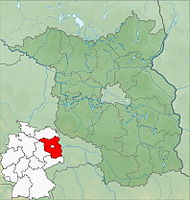




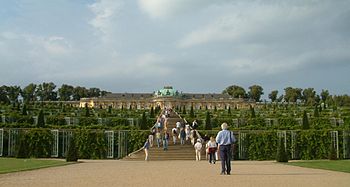



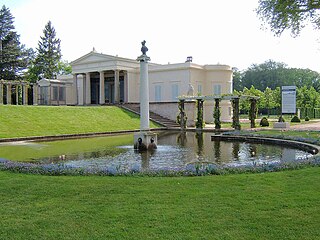

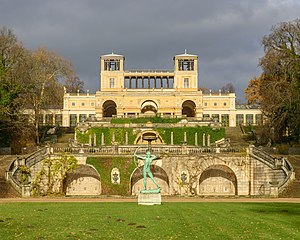















.jpg/350px-Am_Pfingstberg_(5919341582).jpg)



.jpg/320px-Potsdam_Alexandrowka_-_panoramio_(2).jpg)





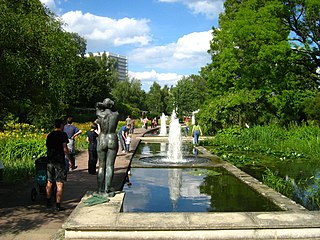









.jpg/308px-Carl_Hasenpflug_-_Garnisonkirche_Potsdam_(1827).jpg)





